2014 Hyundai Santa Fe warning
[x] Cancel search: warningPage 42 of 711
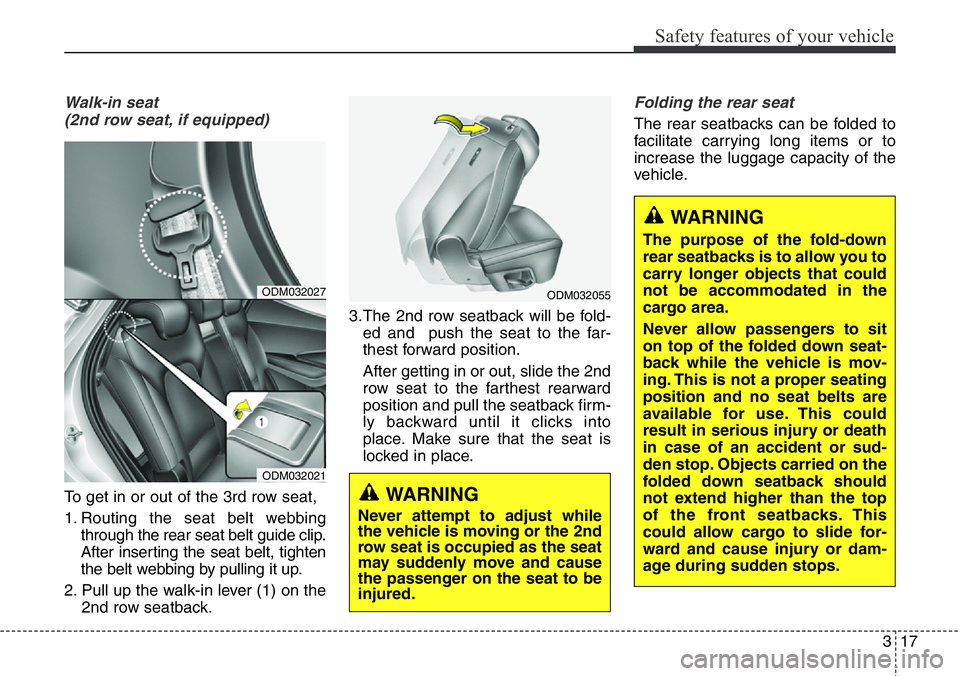
317
Safety features of your vehicle
Walk-in seat
(2nd row seat, if equipped)
To get in or out of the 3rd row seat,
1. Routing the seat belt webbing
through the rear seat belt guide clip.
After inserting the seat belt, tighten
the belt webbing by pulling it up.
2. Pull up the walk-in lever (1) on the
2nd row seatback.3.The 2nd row seatback will be fold-
ed and push the seat to the far-
thest forward position.
After getting in or out, slide the 2nd
row seat to the farthest rearward
position and pull the seatback firm-
ly backward until it clicks into
place. Make sure that the seat is
locked in place.
Folding the rear seat
The rear seatbacks can be folded to
facilitate carrying long items or to
increase the luggage capacity of the
vehicle.
ODM032055
WARNING
The purpose of the fold-down
rear seatbacks is to allow you to
carry longer objects that could
not be accommodated in the
cargo area.
Never allow passengers to sit
on top of the folded down seat-
back while the vehicle is mov-
ing. This is not a proper seating
position and no seat belts are
available for use. This could
result in serious injury or death
in case of an accident or sud-
den stop. Objects carried on the
folded down seatback should
not extend higher than the top
of the front seatbacks. This
could allow cargo to slide for-
ward and cause injury or dam-
age during sudden stops.
WARNING
Never attempt to adjust while
the vehicle is moving or the 2nd
row seat is occupied as the seat
may suddenly move and cause
the passenger on the seat to be
injured.
ODM032027
ODM032021
Page 45 of 711

Safety features of your vehicle
20 3
2nd row seat folding
(from outside, if equipped)
Pull the 2nd row seat back folding
lever out.
The 2nd row seat back will be folded.
If you pull the left side lever (1) out,
left side seat back and center seat
back will be folded.
If you pull the right side lever (2) out,
right side seat back will be folded.
To fold down the rear center seat-
back (for 2nd row seat)
1. Lower the rear headrests to the
lowest position.
2. Push the center seatback folding
lever up, then fold the seat toward
the front of the vehicle.
When you return the seatback to its
upright position, always be sure it
has locked into position by pushing
on the top of the seatback.
ODM032050
WARNING - Rear seat
folding
Do not fold the rear seats (2nd &
3rd row seats), if passengers,
pets or luggage are in the rear
seats.
It may cause injury or damage
to passengers, pets, luggage.
ODM032033
Page 46 of 711
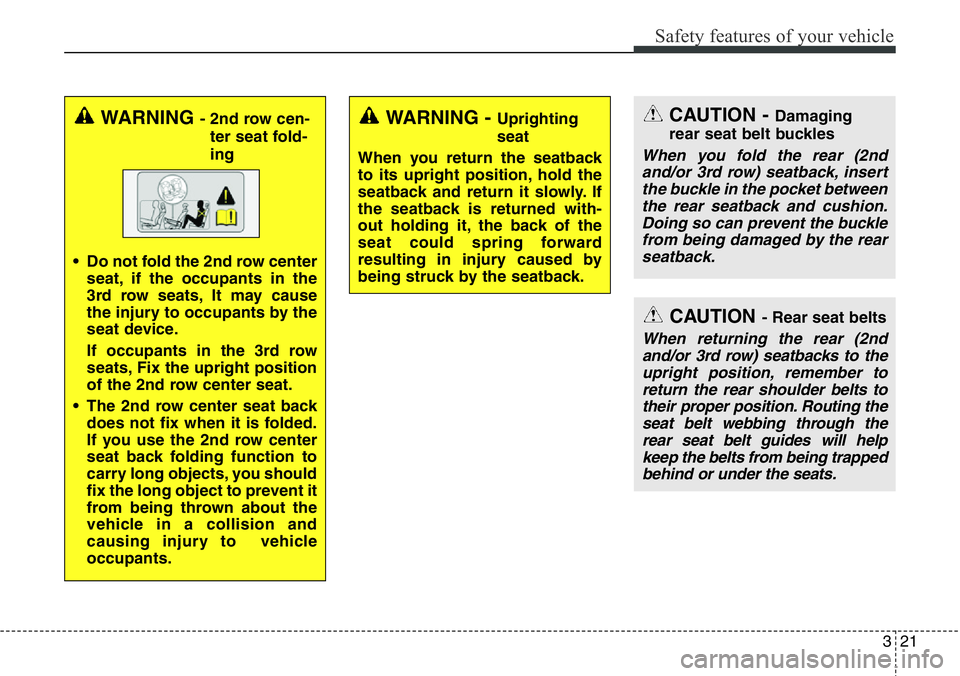
321
Safety features of your vehicle
WARNING - 2nd row cen-
ter seat fold-
ing
• Do not fold the 2nd row center
seat, if the occupants in the
3rd row seats, It may cause
the injury to occupants by the
seat device.
If occupants in the 3rd row
seats, Fix the upright position
of the 2nd row center seat.
• The 2nd row center seat back
does not fix when it is folded.
If you use the 2nd row center
seat back folding function to
carry long objects, you should
fix the long object to prevent it
from being thrown about the
vehicle in a collision and
causing injury to vehicle
occupants.
CAUTION- Rear seat belts
When returning the rear (2nd
and/or 3rd row) seatbacks to the
upright position, remember to
return the rear shoulder belts to
their proper position. Routing the
seat belt webbing through the
rear seat belt guides will help
keep the belts from being trapped
behind or under the seats.
CAUTION - Damaging
rear seat belt buckles
When you fold the rear (2nd
and/or 3rd row) seatback, insert
the buckle in the pocket between
the rear seatback and cushion.
Doing so can prevent the buckle
from being damaged by the rear
seatback.
WARNING - Uprighting
seat
When you return the seatback
to its upright position, hold the
seatback and return it slowly. If
the seatback is returned with-
out holding it, the back of the
seat could spring forward
resulting in injury caused by
being struck by the seatback.
Page 47 of 711
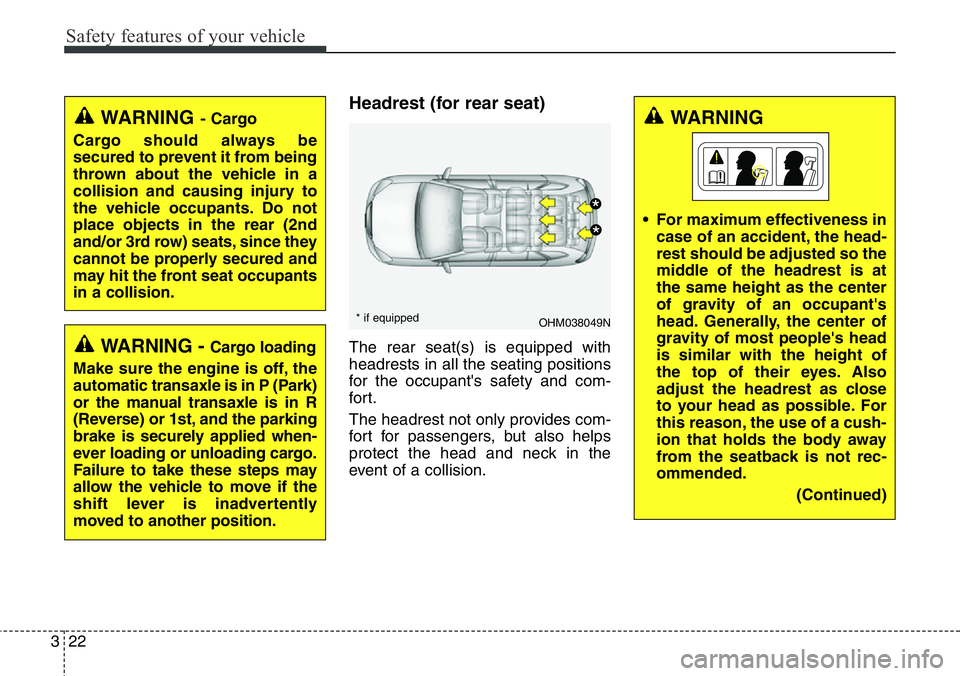
Safety features of your vehicle
22 3
Headrest (for rear seat)
The rear seat(s) is equipped with
headrests in all the seating positions
for the occupant's safety and com-
for t.
The headrest not only provides com-
fort for passengers, but also helps
protect the head and neck in the
event of a collision.
WARNING- Cargo
Cargo should always be
secured to prevent it from being
thrown about the vehicle in a
collision and causing injury to
the vehicle occupants. Do not
place objects in the rear (2nd
and/or 3rd row) seats, since they
cannot be properly secured and
may hit the front seat occupants
in a collision.
WARNING - Cargo loading
Make sure the engine is off, the
automatic transaxle is in P (Park)
or the manual transaxle is in R
(Reverse) or 1st, and the parking
brake is securely applied when-
ever loading or unloading cargo.
Failure to take these steps may
allow the vehicle to move if the
shift lever is inadvertently
moved to another position.
OHM038049N
*
*
* if equipped
WARNING
• For maximum effectiveness in
case of an accident, the head-
rest should be adjusted so the
middle of the headrest is at
the same height as the center
of gravity of an occupant's
head. Generally, the center of
gravity of most people's head
is similar with the height of
the top of their eyes. Also
adjust the headrest as close
to your head as possible. For
this reason, the use of a cush-
ion that holds the body away
from the seatback is not rec-
ommended.
(Continued)
Page 49 of 711
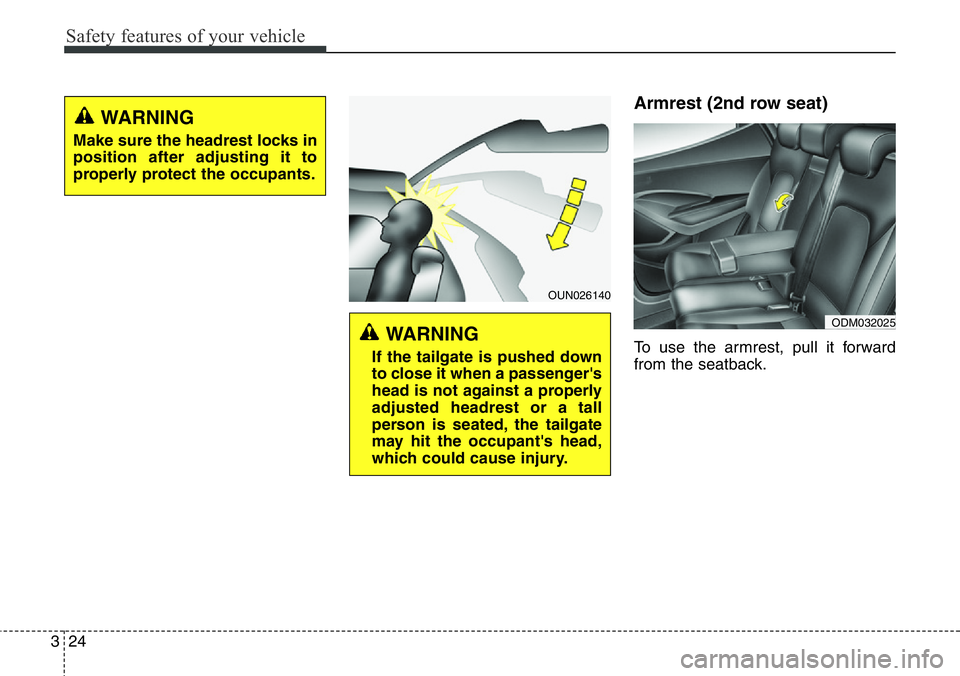
Safety features of your vehicle
24 3
Armrest (2nd row seat)
To use the armrest, pull it forward
from the seatback.
ODM032025
OUN026140
WARNING
If the tailgate is pushed down
to close it when a passenger's
head is not against a properly
adjusted headrest or a tall
person is seated, the tailgate
may hit the occupant's head,
which could cause injury.
WARNING
Make sure the headrest locks in
position after adjusting it to
properly protect the occupants.
Page 51 of 711
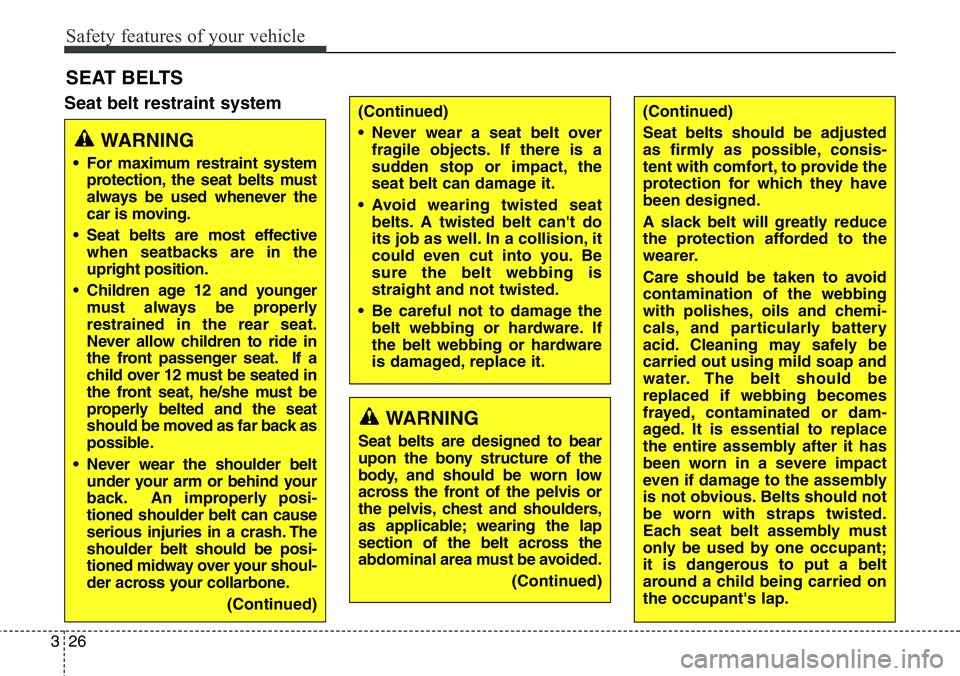
Safety features of your vehicle
26 3
Seat belt restraint system
SEAT BELTS
(Continued)
• Never wear a seat belt over
fragile objects. If there is a
sudden stop or impact, the
seat belt can damage it.
• Avoid wearing twisted seat
belts. A twisted belt can't do
its job as well. In a collision, it
could even cut into you. Be
sure the belt webbing is
straight and not twisted.
• Be careful not to damage the
belt webbing or hardware. If
the belt webbing or hardware
is damaged, replace it.
WARNING
Seat belts are designed to bear
upon the bony structure of the
body, and should be worn low
across the front of the pelvis or
the pelvis, chest and shoulders,
as applicable; wearing the lap
section of the belt across the
abdominal area must be avoided.
(Continued)
WARNING
• For maximum restraint system
protection, the seat belts must
always be used whenever the
car is moving.
• Seat belts are most effective
when seatbacks are in the
upright position.
• Children age 12 and younger
must always be properly
restrained in the rear seat.
Never allow children to ride in
the front passenger seat. If a
child over 12 must be seated in
the front seat, he/she must be
properly belted and the seat
should be moved as far back as
possible.
• Never wear the shoulder belt
under your arm or behind your
back. An improperly posi-
tioned shoulder belt can cause
serious injuries in a crash. The
shoulder belt should be posi-
tioned midway over your shoul-
der across your collarbone.
(Continued)
(Continued)
Seat belts should be adjusted
as firmly as possible, consis-
tent with comfort, to provide the
protection for which they have
been designed.
A slack belt will greatly reduce
the protection afforded to the
wearer.
Care should be taken to avoid
contamination of the webbing
with polishes, oils and chemi-
cals, and particularly battery
acid. Cleaning may safely be
carried out using mild soap and
water. The belt should be
replaced if webbing becomes
frayed, contaminated or dam-
aged. It is essential to replace
the entire assembly after it has
been worn in a severe impact
even if damage to the assembly
is not obvious. Belts should not
be worn with straps twisted.
Each seat belt assembly must
only be used by one occupant;
it is dangerous to put a belt
around a child being carried on
the occupant's lap.
Page 52 of 711

327
Safety features of your vehicle
Seat belt warning
Ty p e A
As a reminder to the driver, the seat
belt warning light will blink for
approximately 6 seconds each time
you turn the ignition switch ON
regardless of belt fastening.
If the driver’s seat belt is unfastened
after the ignition switch is ON, the
seat belt warning light blinks again
for approximately 6 seconds.
1GQA2083
WARNING
• No modifications or additions
should be made by the user
which will either prevent the
seat belt adjusting devices
from operating to remove
slack, or prevent the seat belt
assembly from being adjusted
to remove slack.
• When you fasten the seat belt,
be careful not to latch the seat
belt in buckles of other seat. It's
very dangerous and you may
not be protected by the seat
belt properly.
• Do not unfasten the seat belt
and do not fasten and unfas-
ten the seat belt repeatedly
while driving. This could
result in loss of control, and
an accident causing death,
serious injury, or property
damage.
(Continued)
(Continued)
• When fastening the seat belt,
make sure that the seat belt
does not pass over objects that
are hard or can break easily.
• Make sure there is nothing in
the buckle. The seat belt may
not be fastened securely.
Page 53 of 711
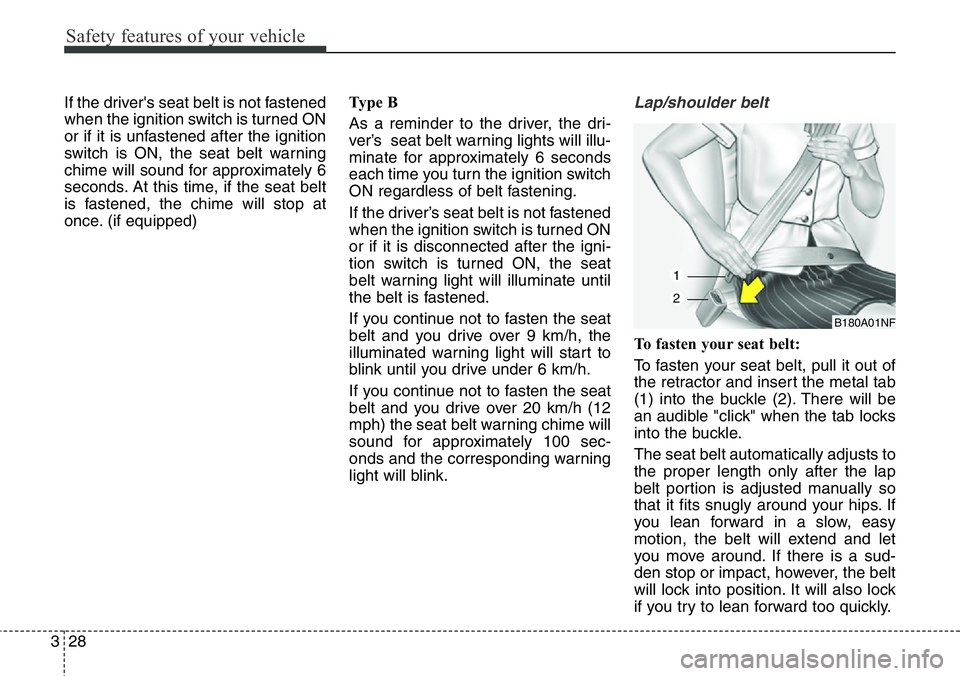
Safety features of your vehicle
28 3
If the driver's seat belt is not fastened
when the ignition switch is turned ON
or if it is unfastened after the ignition
switch is ON, the seat belt warning
chime will sound for approximately 6
seconds. At this time, if the seat belt
is fastened, the chime will stop at
once. (if equipped)Ty p e B
As a reminder to the driver, the dri-
ver’s seat belt warning lights will illu-
minate for approximately 6 seconds
each time you turn the ignition switch
ON regardless of belt fastening.
If the driver’s seat belt is not fastened
when the ignition switch is turned ON
or if it is disconnected after the igni-
tion switch is turned ON, the seat
belt warning light will illuminate until
the belt is fastened.
If you continue not to fasten the seat
belt and you drive over 9 km/h, the
illuminated warning light will start to
blink until you drive under 6 km/h.
If you continue not to fasten the seat
belt and you drive over 20 km/h (12
mph) the seat belt warning chime will
sound for approximately 100 sec-
onds and the corresponding warning
light will blink.Lap/shoulder belt
To fasten your seat belt:
To fasten your seat belt, pull it out of
the retractor and insert the metal tab
(1) into the buckle (2). There will be
an audible "click" when the tab locks
into the buckle.
The seat belt automatically adjusts to
the proper length only after the lap
belt portion is adjusted manually so
that it fits snugly around your hips. If
you lean forward in a slow, easy
motion, the belt will extend and let
you move around. If there is a sud-
den stop or impact, however, the belt
will lock into position. It will also lock
if you try to lean forward too quickly.
B180A01NF
1
2